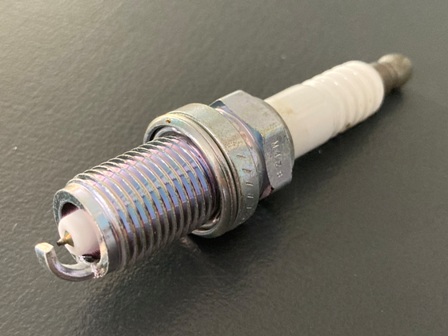What is a Spark Plug
Spark plugs are components of gasoline internal combustion engine (Diesel engines do not use spark plugs). Spark plugs date back to early 1800s. That’s a couple decades earlier than introduction of commercial internal combustion engine. First spark plug to resemble modern ones which we use on internal combustion engines today, was patented in Germany in 1903.
Spark plugs do not get a second thought from drivers, even though spark plugs are vital for optimal engine operation and maximizing fuel efficiency. Usually, most people change spark plugs when their engine start to misfire.
Sparks plugs should not be a repair item but a maintenance item. Spark plugs should be replaced prior to failure at manufacturers recommendation intervals. Another reason for replacing spark plugs before failure, is ignition coils. Old or worn spark plugs create higher resistance and will overtime kill ignition coils.
Spark Plugs Basics by spark plug manufacturer NGK.
What is a Spark Plug
Spark plug is an electrical device designed to create spark. Ignition coils supply high electrical voltage to spark plugs electrodes. Spark plugs ignite fuel air mixture inside engine burning chambers. Major components of spark plugs are: housing, electrodes and insulator.
1. Housing
Housing is metallic part of spark plug lower body. Lower part of housing is threaded and installed on engine cylinder head. Ground spark electrode is part of spark plug lower housing. Housing also serves as electrode ground connection and helps transfer heat cooling spark plug during operation.
2. Insulator
Insulates high voltage center electrode running along axis of spark plug body, from top to bottom. Insulator is covered with a layer of porcelain material. Since insulator extends all the way to bottom of spark plug, its designed to withstand heat generated on combustion chamber.
3. Center electrode
It runs along the axis inside of spark plug body. Center electrode takes high voltage current from top connection with ignition coil and transmits voltage to lower part of center electrode, located inside cylinder chamber. Center electrodes are made with expensive materials, Platinum and Iridium. Both these metals are high heat resistant.
4. Ground electrode
Ground electrode is part of lower housing. Electrodes are fabricated using nickel alloy materials. Ground electrode sits at a specified gap (or distance) from center electrode, together these electrodes create spark which ignites fuel air mixture. Ground electrode operates inside cylinder burning chamber and needs to withstand high heat and high pressures created during combustion process.
How Spark Plug Work
High voltage up to 40,000 volts from ignition coil (engine ignition system) runs along center electrode axis. High voltage will create a discharge spark when current passes between center and ground electrodes igniting fuel inside cylinder burning chamber.
Sparks are very brief, less than one thousands of a second. Electrical current flow between tow electrodes is interrupted and a discharge is created. This discharge or spark will ignite fuel/air mixture and start combustion process.
Engine Ignition Timing
Ignition timing is timing when spark plugs fire and ignite fuel inside each cylinder. Modern engine timing is controlled electronically by ECU or Electronic Control Unit. Earlier engines used a distributor and mechanical spark plug timing. Car ECU collects information from camshaft and crankshaft sensor to adjust engine timing for optimal fuel burn and peak engine performance.
How Spark Plugs Fail
Spark plugs “live” and work in a very harsh environment. Cylinder burning chamber reaches high pressures up to 1000psi on load and high heat up to 250 Celsius. Spark plugs will withstand these forces for long periods of time, however there is a limit.
Spark plug failure is usually result of overheating or carbon build up on spark electrodes. Failed or worn spark plugs will manifest with lower fuel economy, loss of power, lack of acceleration, multiple or single cylinder misfires, hard starting cold engines, irregular engine idle.
Oil contamination can cause spark plug failure. Over time piston rings or seals will deteriorate and allow engine oil in cylinder chamber. Oil will contaminate and wear spark plug center and ground electrodes.
Insulator casing crack is another reason doe spark plug failure. Insulator can crack due to overheating or early fuel detonation due to use of lower than recommended octane gasoline. If insulator breaks or crack spark plug will not operate normally and engine misfires will develop.
When to Change Spark Plugs
Spark plugs are part of routine maintenance. Spark plugs should be replaced at manufacturers recommended intervals. Usually at 80-100,000km intervals depending on spark plug type. However, some spark plug manufacturers are claiming close to 200,000km change intervals. Which is most likely unrealistic: When to Change Spark Plugs.
Spark plugs will affect reliability of other engine components, worn or old spark plugs overload and shorten ignition coil lifespan. Replacing spark plugs at recommended intervals (earlier is better) will keep fuel efficiency optimal and increase reliability of your used car.
Why You Should Replace Spark Plugs
Spark plugs ignite fuel inside cylinder chamber. Fuel ignition is the most important part of internal combustion engine. After all, it is a combustion engine relying on fuel combustion. Most common symptom of failed or worn spark plugs is engine misfire.
If spark plugs do not fire reliably at certain intervals, fuel combustion will be interrupted and this is called engine misfire. Misfires can be on one cylinder or multiple cylinders and can cause engine damage.
Most common symptoms of spark plug failure are:
- Reduced fuel efficiency
- Hard cold engine starts
- Engine misfires
- Bad engine idling
- Reduced engine power
- Poor overall engine performance
Depending on spark plug type, replacement intervals vary between 50,000 to 100,000km, with Iridium spark plugs having longest lifespan. Iridium spark plugs are also more expensive. Replacing spark plugs at recommended intervals will ensure your engine stays at peak performance while giving you best fuel efficiency.
(If you are also looking for a fast and easy solution to sell your car, more here on “How To Sell Your Car Fast In Ontario”. )















